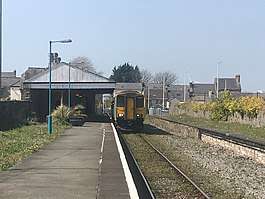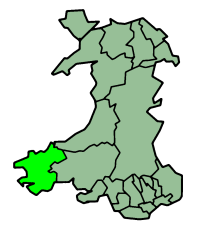Pembroke Dock railway station
| Pembroke Dock | |
|---|---|
| Welsh: Doc Penfro | |
 April 2018 | |
| Location | |
| Place | Pembroke Dock |
| Local authority | Pembrokeshire |
| Coordinates | 51°41′38″N 4°56′17″W / 51.694°N 4.938°WCoordinates: 51°41′38″N 4°56′17″W / 51.694°N 4.938°W |
| Grid reference | SM970035 |
| Operations | |
| Station code | PMD |
| Managed by | Transport for Wales |
| Number of platforms | 1 |
| DfT category | F1 |
|
Live arrivals/departures, station information and onward connections from National Rail Enquiries | |
| Annual rail passenger usage* | |
| 2012/13 |
|
| 2013/14 |
|
| 2014/15 |
|
| 2015/16 |
|
| 2016/17 |
|
| History | |
| Original company | Pembroke and Tenby Railway |
| Pre-grouping | Great Western Railway |
| Post-grouping | Great Western Railway |
| 8 August 1864 | Station opened |
| National Rail – UK railway stations | |
| * Annual estimated passenger usage based on sales of tickets in stated financial year(s) which end or originate at Pembroke Dock from Office of Rail and Road statistics. Methodology may vary year on year. | |
|
| |
Pembroke Dock railway station serves the town of Pembroke Dock in Pembrokeshire, Wales. It is the terminus of the Pembroke Dock branch of West Wales Lines from Swansea, 27 1⁄4 miles (44 km) southwest of Whitland.
It was opened on 8 August 1864 by the Pembroke and Tenby Railway[1] as an extension of their route from Pembroke to serve the Royal Navy dockyard in the town, though it was not until 1866 that the P&T route finally reached the main line at Whitland. The line was notable when constructed as it was built as standard gauge, not the 7-foot broad gauge used by the Great Western Railway at the time; and so it was isolated from the South Wales Railway main line until 1868, when dual gauge track was laid as far as Carmarthen to meet the standard gauge tracks of the London and North Western Railway. In 1872, the GWR converted all of its lines in the area to standard gauge.

Originally, the station had two platforms. Both remain but only the southern one is in use. Part of the main building has been converted into The Station Inn, a real ale pub.[2] Originally carrying munitions, the freight branch ran past the station across local streets down to the actual dockside until 1969. Subsequently, albeit partially, the track has been lifted.
Transport for Wales Rail is the operator; the station is unstaffed; ticket machine is installed; CIS displays provide train running information in addition to the standard timetable poster boards and public telephone. The station canopies remain to provide a covered waiting area with bench seating. There are no waiting rooms. Level access is available from the car park and at the main entrance to the platform.[3]
There is a regular daily service to/from Swansea via Carmarthen and Whitland, with some through trains to/from Cardiff Central and further east (one service originating at Manchester Piccadilly). Connections are available at Swansea for mainline destinations at other times. Trains run every two hours Mon-Sat,[4] with a less frequent service on Sundays.
On summer Saturdays, the station is also used by Great Western Railway who provide two InterCity 125s in each direction: two to London Paddington, one from London Paddington and one early morning HST starting its journey from Swansea. One through train in each direction is named the Pembroke Coast Express.
Notes
- ↑ Butt, R.V.J. (1995). The Directory of Railway Stations. Yeovil: Patrick Stephens Ltd. p. 182. ISBN 1-85260-508-1. R508.
- ↑ Railscot - Pembroke Dock www.railbrit.co.uk; Retrieved 2013-11-22
- ↑ Pembroke Dock station facilities National Rail Enquiries; Retrieved 6 April 2017
- ↑ GB National Rail Timetable 2016-17, Table 128
External links
- Train times and station information for Pembroke Dock railway station from National Rail
| Preceding station | Following station | |||
|---|---|---|---|---|
| Pembroke | Transport for Wales West Wales line |
Terminus | ||
| Pembroke | Great Western Railway London - Pembroke Summer Saturdays |
Terminus | ||
| Terminus | Irish Ferries Ferry |
Rosslare Europort | ||

